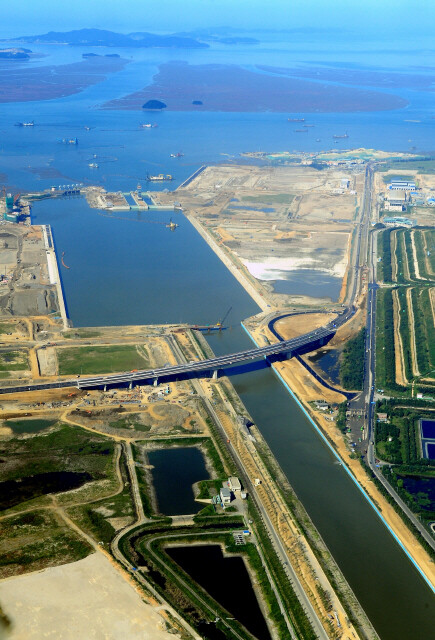hankyoreh
Links to other country sites 다른 나라 사이트 링크
Taxpayers to front $1.3B for Gyeongin Ara Waterway

By Kim Young-hwan, Incheon Correspondent
Criticisms erupted over the Gyeongin (Seoul-Incheon) Ara Waterway after a recent parliamentary audit revealed that the Korea Water Resources Corporation (K-Water) demanded 500 billion won ($440.5 million) in state money from the government along with 20 billion per year for sluice gate and waterway maintenance.
Democratic Labor Party (DLP) Lawmaker Kang Ki-kab charged that the waterway is living up to initial fears that it would turn into a “tax money pit.” Democratic Party lawmaker Lew Seon-ho said that with the return upon construction amounting to only 700 billion won or so on an investment of 2.25 trillion won, the waterway will lose around 37.5 billion won per year, for a total of 1.5 trillion won.
K-Water responded by issuing materials stating that it merely asked for management expenses from the government because the harbor and waterway are state property.
The corporation said that following test runs of passenger boats on Oct. 29, it would be possible to begin test runs of freight vessels and yachts, in that order, so that 18 vessels would be able to begin travel as planned by March 2012, with nine freight vessels and nine passenger boats.
But experts said a waterway would only be competitive when large amounts of low-cost freight are carried for long distances over long periods, but that this would not be possible for the Seoul-Incheon waterway, leaving it a “waterway without boats.”
Traveling as far as the Ara Waterway would require the payment of addition costs in fuel and ferry charges, and large vessels would be unable to navigate the waterway, which measures 80 meters across.
Incheon Port Development Council head Lee Gwi-bok said, “The Ara Waterway does not allow cross traffic because of concerns about a collision between vessels under even slightly windy conditions, and large vessels cannot travel the area below Yeongjong Bridge because of the strong currents.”
In light of these concerns, the Incheon Regional Maritime Affairs and Port Office stated in an announcement that vessels should travel at 10 knots (18.5 km/h) or less, but restricted the speed to under eight knots for curved sections, while disallowing crossing and passing for vessels wider than 20 meters.
Lim Suk-min, Hanshin University professor and distribution and maritime transport specialist, said, “There needs to be a lot of cargo using the harbor, with a lot of factories behind it, but this not the case around the Ara Waterway.”
“With Incheon Harbor and the South Harbor nearby and the North Harbor and Songdo New Harbor under construction, there is no reason for freight vessels to use the Ara Waterway at additional expense,” Lim added.
The city of Gimpo and a number of citizens are anticipating increased tourism and leisure demand with the opening of a waterway between the West Sea and Han River, as well as rising home values as the area around the waterway is developed.
But Lim, noting that the passenger boat currently plying in the Han River is planning a company selloff owing to management problems, said, “Few people are likely to put in the extra time and expenses to ride a passenger boat on the Seoul-Incheon Ara Waterway, which has even fewer sights to see.”
A report by the Incheon Development Institute also said that with more attention given to size than design for the nine bridges over the waterway, they will be unable to offer any attractions for tourists.
Please direct questions or comments to [englishhani@hani.co.kr]
Editorial・opinion
![[Column] Season 2 of special prosecutor probe may be coming to Korea soon [Column] Season 2 of special prosecutor probe may be coming to Korea soon](https://flexible.img.hani.co.kr/flexible/normal/500/300/imgdb/original/2024/0426/3317141030699447.jpg) [Column] Season 2 of special prosecutor probe may be coming to Korea soon
[Column] Season 2 of special prosecutor probe may be coming to Korea soon![[Column] Park Geun-hye déjà vu in Yoon Suk-yeol [Column] Park Geun-hye déjà vu in Yoon Suk-yeol](https://flexible.img.hani.co.kr/flexible/normal/500/300/imgdb/original/2024/0424/651713945113788.jpg) [Column] Park Geun-hye déjà vu in Yoon Suk-yeol
[Column] Park Geun-hye déjà vu in Yoon Suk-yeol- [Editorial] New weight of N. Korea’s nuclear threats makes dialogue all the more urgent
- [Guest essay] The real reason Korea’s new right wants to dub Rhee a founding father
- [Column] ‘Choson’: Is it time we start referring to N. Korea in its own terms?
- [Editorial] Japan’s rewriting of history with Korea has gone too far
- [Column] The president’s questionable capacity for dialogue
- [Column] Are chaebol firms just pizza pies for families to divvy up as they please?
- [Column] Has Korea, too, crossed the Rubicon on China?
- [Correspondent’s column] In Japan’s alliance with US, echoes of its past alliances with UK
Most viewed articles
- 1Is Japan about to snatch control of Line messenger from Korea’s Naver?
- 2‘We must say no’: Seoul defense chief on Korean, USFK involvement in hypothetical Taiwan crisis
- 3[News analysis] Using lure of fame, K-entertainment agency bigwigs sexually prey on young trainees
- 4Will NewJeans end up collateral damage in internal feud at K-pop juggernaut Hybe?
- 5‘Weddingflation’ breaks the bank for Korean couples-to-be
- 6No good, very bad game for Korea puts it out of Olympics for first time since 1988
- 7AI is catching up with humans at a ‘shocking’ rate
- 8“Korea is so screwed!”: The statistic making foreign scholars’ heads spin
- 9The dream K-drama boyfriend stealing hearts and screens in Japan
- 10[Column] The clock is ticking for Korea’s first lady